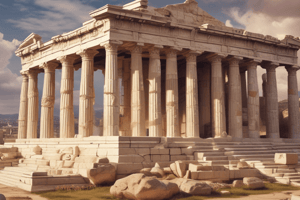Podcast
Questions and Answers
What were the two major city-states in ancient Greece?
What were the two major city-states in ancient Greece?
Athens and Sparta
What was the primary form of government in Sparta?
What was the primary form of government in Sparta?
- Oligarchy (correct)
- Monarchy
- Theocracy
- Democracy
Why were Athenians more open to outsider ideas compared to Spartans?
Why were Athenians more open to outsider ideas compared to Spartans?
Due to their geographic location and trade relationships.
Athens allowed women to be considered citizens.
Athens allowed women to be considered citizens.
What was a significant aspect of Athenian economy?
What was a significant aspect of Athenian economy?
Spartan education focused on arts and philosophy.
Spartan education focused on arts and philosophy.
In Sparta, slaves were known as _____ and were treated harshly.
In Sparta, slaves were known as _____ and were treated harshly.
What was the main purpose of education in Sparta?
What was the main purpose of education in Sparta?
What was the Agora in Athens?
What was the Agora in Athens?
Spartan women had fewer rights than women in Athens.
Spartan women had fewer rights than women in Athens.
What were Spartan boys trained to endure from a young age?
What were Spartan boys trained to endure from a young age?
Study Notes
Introduction to City-States
- Ancient Greece was a collection of city-states, each with unique governance and lifestyles.
- Athens, a coastal city with master craftsmen and active trade, showcased a democratic society focused on debates.
- Sparta, a land-locked city with simpler structures and an emphasis on military strength, lacked city walls and was less open to outsiders.
Comparing Athens and Sparta
- Athens (central Greece) was 4 miles from the Aegean Sea, fostering trade and cultural exchange.
- Sparta (Peloponnesus) was more isolated, leading to a focus on self-sufficiency and military prowess.
- Differences were reflected in societal values: Athens promoted arts and culture, while Sparta emphasized discipline and simplicity.
Athenian Government
- Emerged as a democracy around 500 BCE; only free males over 18 could participate.
- The Council of 500 managed daily government operations; members were randomly selected annually.
- The Assembly, consisting of citizens, required at least 6,000 for meetings and debated laws.
Athenian Economy
- Relied heavily on trade due to insufficient local food production.
- Engaged with various regions for resources: wood from Italy, grain from Egypt, and traded goods like olive oil and pottery.
- The Agora served as a bustling marketplace for buying food, goods, and slaves; Athenian coins featured images of Athena and the owl.
Education in Athens
- Aimed at cultivating good citizens; focused on both physical training and intellectual learning.
- Boys attended school from ages 6-14, learning reading, writing, and sports; girls were primarily trained in domestic skills.
- Wealthy boys received additional training in debate and public speaking, while girls prepared for marriage at around 15.
Women and Slaves in Athens
- Women had limited rights, could not own property, vote, or attend the Assembly, and were mainly confined to the home.
- Majority of Athenian women had domestic roles, educating children and managing households.
- Slaves, both born and captured, performed various skilled and unskilled jobs; treatment varied widely depending on their roles.
Spartan Government
- Governed by an oligarchy; significant power held by the Council of Elders, consisting of 2 kings and 28 nobles.
- Assembly could only vote on laws proposed by the Council, which held actual legislative power.
- Spartan Assembly met in an open space; decisions were made without in-depth debates.
Spartan Economy
- Relied on agriculture and military conquest for resources; conquered lands provided food through helots.
- The helots worked the fields and inhabited their own villages, while non-citizens (perioikoi) produced goods but could not participate in governance.
- Spartan currency comprised heavy iron bars, discouraging trade to maintain control over citizens and ideas from outsiders.
Education in Sparta
- Focused on producing strong, disciplined warriors; unhealthy infants were often left to die.
- Military training began at age 7, encompassing both boys and girls; reading and writing were less emphasized than combat skills.
- Boys lived in barracks to train until age 30, maintaining military bonds and conforming to soldierly conduct.
Women and Slaves in Sparta
- Spartan women shared responsibilities with men, managing properties and displaying strength.
- They enjoyed more rights than Athenian women, including property ownership and the ability to remarry if widowed.
- Helots, conquered peoples, outnumbered citizens significantly, leading to harsh treatment and control by the Spartan government; some enjoyed basic rights like marriage and economic transactions.
Studying That Suits You
Use AI to generate personalized quizzes and flashcards to suit your learning preferences.
Description
This quiz focuses on the contrasting lifestyles and governments of two significant city-states in ancient Greece: Athens and Sparta. You'll explore their unique characteristics, including Athens' maritime trade and Sparta's military culture. Get ready to dive into the fascinating world of ancient Greek city-states!




